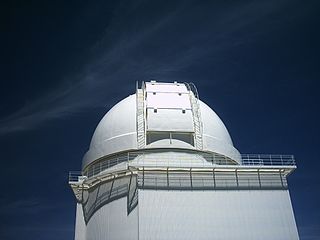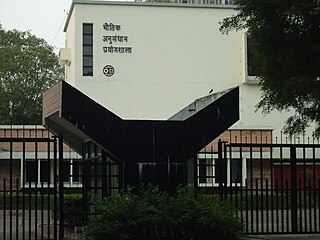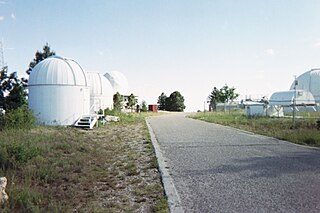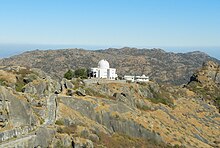
An observatory is a location used for observing terrestrial, marine, or celestial events. Astronomy, climatology/meteorology, geophysical, oceanography and volcanology are examples of disciplines for which observatories have been constructed. Historically, observatories were as simple as containing an astronomical sextant or Stonehenge.

The Very Large Telescope (VLT) is a telescope facility operated by the European Southern Observatory on Cerro Paranal in the Atacama Desert of northern Chile. It consists of four individual telescopes, each with a primary mirror 8.2 m across, which are generally used separately but can be used together to achieve very high angular resolution. The four separate optical telescopes are known as Antu, Kueyen, Melipal, and Yepun, which are all words for astronomical objects in the Mapuche language. The telescopes form an array complemented by four movable Auxiliary Telescopes (ATs) of 1.8 m aperture.

Subaru Telescope is the 8.2-meter (320 in) flagship telescope of the National Astronomical Observatory of Japan, located at the Mauna Kea Observatory on Hawaii. It is named after the open star cluster known in English as the Pleiades. It had the largest monolithic primary mirror in the world from its commissioning until 2005.

The W. M. Keck Observatory is a two-telescope astronomical observatory at an elevation of 4,145 meters (13,600 ft) near the summit of Mauna Kea in the U.S. state of Hawaii. Both telescopes have 10 m (33 ft) aperture primary mirrors, and when completed in 1993 and 1996 were the largest astronomical telescopes in the world. They are currently the 3rd and 4th largest.

The Gemini Observatory is an astronomical observatory consisting of two 8.1-metre (26.6 ft) telescopes, Gemini North and Gemini South, which are located at two separate sites in Hawaii and Chile, respectively. The twin Gemini telescopes provide almost complete coverage of both the northern and southern skies. They are currently among the largest and most advanced optical/infrared telescopes available to astronomers. (See List of largest optical reflecting telescopes).

The Apache Point Observatory is an astronomical observatory located in the Sacramento Mountains in Sunspot, New Mexico, United States, approximately 18 miles (29 km) south of Cloudcroft. The observatory is operated by New Mexico State University (NMSU) and owned by the Astrophysical Research Consortium (ARC). Access to the telescopes and buildings is private and restricted.

The National Optical Astronomy Observatory (NOAO) is the United States national observatory for ground-based nighttime ultraviolet-optical-infrared (OUVIR) astronomy. The National Science Foundation (NSF) funds NOAO to provide forefront astronomical research facilities for US astronomers. However, professional astronomers from any country in the world may apply to use the telescopes operated by NOAO under the NSF's "open skies" policy. Astronomers submit proposals for peer review to gain access to the telescopes which are scheduled every night of the year for observations. The combination of truly open access and the merit based science proposal process makes NOAO unique in the world.

NASA's series of Great Observatories satellites are four large, powerful space-based astronomical telescopes launched between 1990 and 2003. They were built with different technology to examine specific wavelength/energy regions of the electromagnetic spectrum: gamma rays, X-rays, visible and ultraviolet light, and infrared light.

The Galileo National Telescope, is a 3.58-meter Italian telescope, located at the Roque de los Muchachos Observatory on the island of La Palma in the Canary Islands, Spain. The TNG is operated by the "Fundación Galileo Galilei, Fundación Canaria", a non-profit institution, on behalf of the Italian National Institute of Astrophysics (INAF). The telescope saw first light in 1998 and is named after the Italian Renaissance astronomer Galileo Galilei.

The Canada–France–Hawaii Telescope (CFHT) is located near the summit of Mauna Kea mountain on Hawaii's Big Island at an altitude of 4,204 meters, part of the Mauna Kea Observatory. Operational since 1979, the telescope is a Prime Focus/Cassegrain configuration with a usable aperture diameter of 3.58 metres (11.7 ft).

The Indian Astronomical Observatory (IAO), located in Hanle near Leh in Ladakh, India, has one of the world's highest located sites for optical, infrared and gamma-ray telescopes. It is operated by the Indian Institute of Astrophysics, Bangalore. It is currently the tenth highest optical telescope in the world, situated at an elevation of 4,500 meters (14,764 ft).

The Calar Alto Observatory is an astronomical observatory located in Almería province in Spain on Calar Alto, a 2,168-meter-high (7,113 ft) mountain in the Sierra de Los Filabres range.

The Vainu Bappu Observatory is an astronomical observatory owned and operated by the Indian Institute of Astrophysics. It is located at Kavalur in the Javadi Hills, near Vaniyambadi in Tirupattur district in the Indian state of Tamil Nadu. It is 200 km south-west of Chennai and 175 km south-east of Bangalore.

The Physical Research Laboratory (PRL) is a National Research Institute for space and allied sciences, supported mainly by Department of Space, Government of India. This research laboratory has ongoing research programmes in astronomy and astrophysics, atmospheric sciences and aeronomy, planetary and geosciences, Earth sciences, Solar System studies and theoretical physics. It also manages the Udaipur Solar Observatory and Mount Abu InfraRed Observatory. The PRL is located in Ahmedabad.

Mount Lemmon Observatory (MLO), also known as the Mount Lemmon Infrared Observatory, is an astronomical observatory located on Mount Lemmon in the Santa Catalina Mountains approximately 28 kilometers (17 mi) northeast of Tucson, Arizona (US). The site in the Coronado National Forest is used with special permission from the U.S. Forest Service by the University of Arizona's Steward Observatory, and contains a number of independently managed telescopes.

Guru Shikhar, a peak in the Arbuda Mountains of Rajasthan, is the highest point of the Aravalli Range. It rises to an elevation of 1,722 metres (5,650 ft). It is 15 km from Mount Abu and a road from there leads almost to the top of the mountain. It is named Guru-Shikhar or 'the peak of the guru' after Dattatreya, an incarnation of Vishnu, and a cave at the summit contains a temple dedicated to him, plus one dedicated his mother, Anasuya, wife of sage Atri nearby.
An integral field spectrograph, or a spectrograph equipped with an integral field unit (IFU), is an optical instrument combining spectrographic and imaging capabilities, used to obtain spatially resolved spectra in astronomy and other fields of research such as bio-medical science and earth observation.

Origins Space Telescope (Origins) is a concept study for a Far-Infrared Surveyor space telescope mission. A preliminary concept in pre-formulation, it was presented to the United States Decadal Survey in 2019 for a possible selection to NASA's large strategic science missions. Origins would provide an array of new tools for studying star formation and the energetics and physical state of the interstellar medium within the Milky Way using infrared radiation and new spectroscopic capabilities.


















